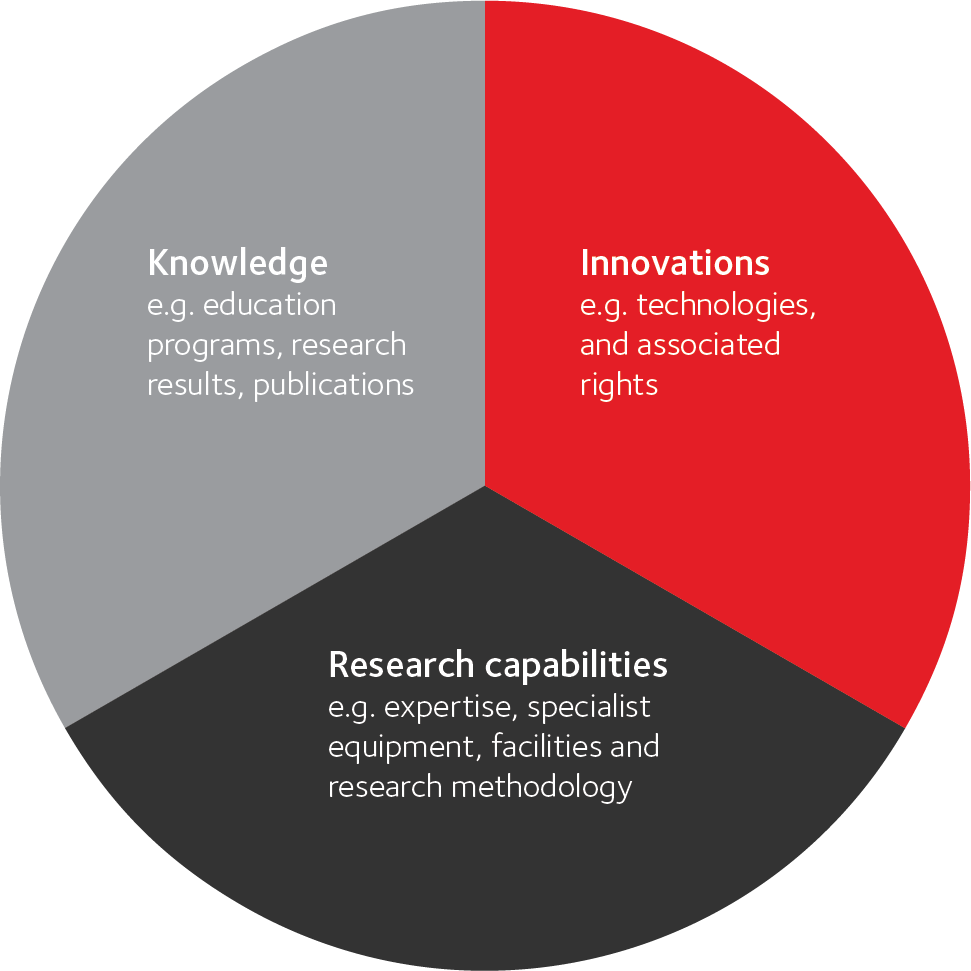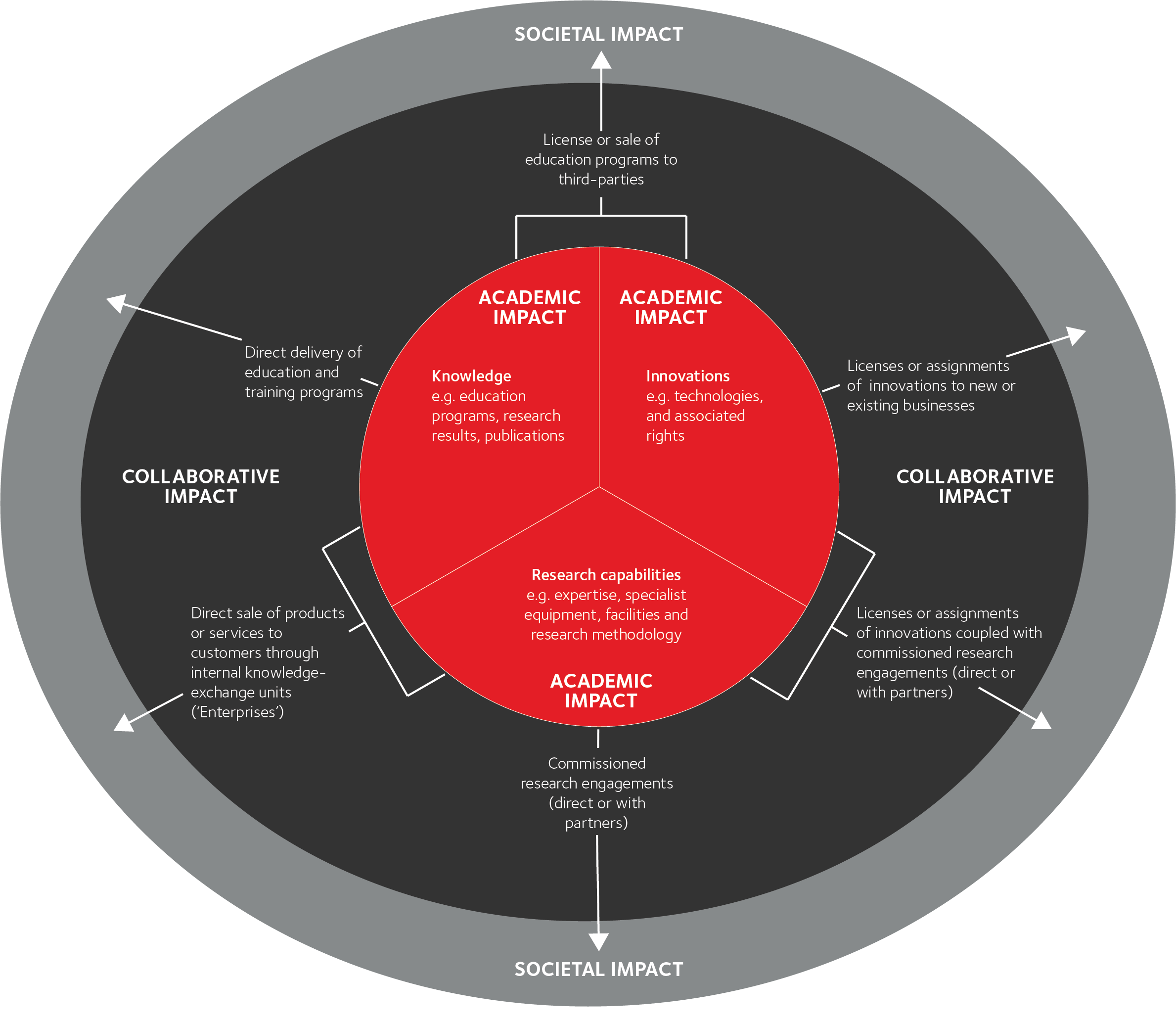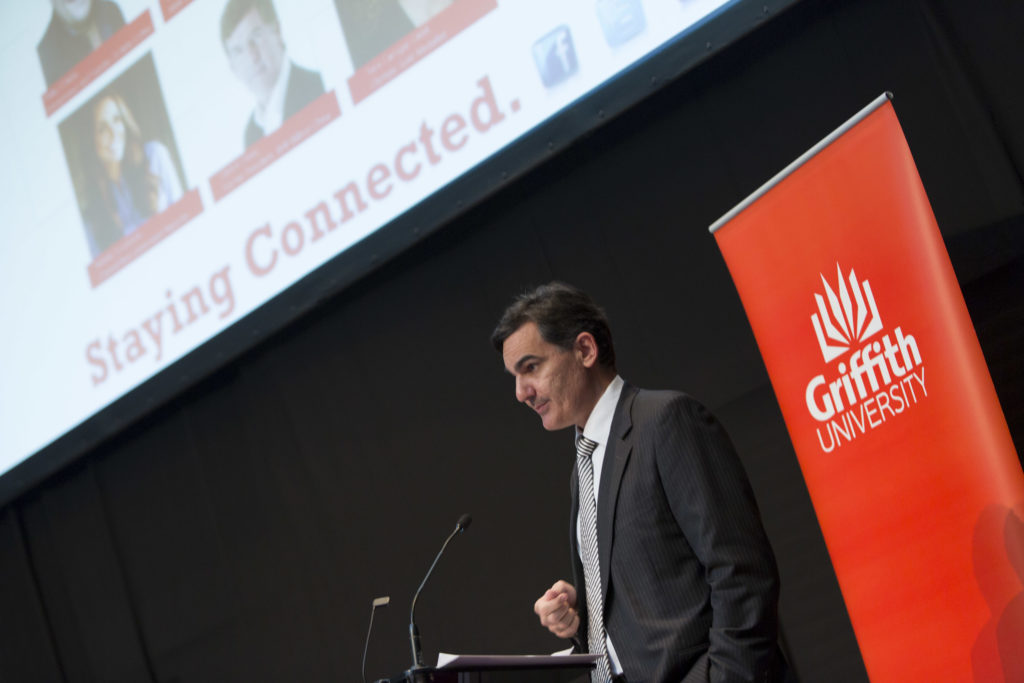This is Section 4 of a series on the topic of ‘deriving impact from universities’ in the 21st century, authored by Nicholas Mathiou, Director of Griffith Enterprise.

“The only real voyage of discovery consists not in seeking new landscapes but in having new eyes.”
– Marcel Proust (1871-1922)
Section 4. Understanding the ‘Knowledge-Capital Value Chain’
Introduction
The omnipresence of rapidly changing environments within which universities now operate has been a presiding theme in the opening sections of this series, prompting the call to focus on the ‘North Stars’ (section 2) that help universities set ‘direction’ and the (‘Spheres of Impact’, section 3) through which universities can better articulate their ‘purposes’. In the case of the former, we pointed to the changing natures of workforces, the rise of innovation and entrepreneurship, and significant societal needs; while the overarching aim to maximising societal impact from tangible education programs and research outcomes through collaborations with partners guided our thinking around the latter. Setting direction and articulating purpose in this way establishes the ‘intent’ which galvanises shared action across a university.
How universities make sense of ways to achieve this ‘intent’ guides the discussion now in section 4, where the important role of the ‘knowledge-capital value chain’ is explained. Shaping a core strategy[1] that sets the framework for achieving intent can only realistically happen through a lucid understanding of this concept and its three key constituent parts. The first of these involves the nature of universities’ underlying resources; the second considers the market segments they address; and the third recognises the various delivery mechanisms that can be utilised.
These constituent parts are not unfamiliar; indeed, they are common to all universities, accepted and acknowledged as staples of the domain of tertiary institutions. What makes them key in this context is how they are perceived – how they are seen by universities in times of change and uncertainty.
Therefore, on the back of due consideration of a university’s ‘North Stars’ and ‘Spheres of Impact’, a refreshed or renewed appreciation of the constituent parts of the ‘knowledge-capital value chain’ and what these can offer when shaping a core strategy is an important next step towards the aim of deriving impact. We start with a closer look at the Nature of Resources.
Nature of resources
The underlying suite of resources available to universities sets them apart from many other organisations in today’s business world.
This suite can be condensed into three main categories, deployed by all universities to create solutions for society. Here we are talking about the potent mix of knowledge, research capabilities and innovations.
 Knowledge:
Knowledge:
For all universities, core business involves the delivery of education programs that are relevant to the needs of students and the wider community. Quality research informs, instructs, and is part of knowledge base that underpins the provision of quality education programs. A university’s ability to provide evidence-based, high quality education programs and research outcomes[2] contributes immense socio-economic benefits and a key competitive advantage.
Research capabilities:
Research capabilities available to a university typically comprise of expertise (e.g. residing with its academic staff), research facilities and equipment, and research methodologies (e.g. systems, processes, techniques, procedures, methods and the like). The breadth of capabilities within a university that can be applied individually or collectively to solve complex problems also provides universities with considerable competitive advantage. The research capabilities of universities underpin both the creation of knowledge (above) and innovations (below).
Innovations:
Universities undertake research that can result in innovations; typically, novel technologies, and new or unique products, services, processes, or designs. For example, innovations may include a new vaccine or drug candidate, a new electrical system, a novel device, a new material and so on. Often intellectual property rights (e.g. patents, trademarks and industrial designs) are associated with novel innovations, shoring up competitive advantage.
Market segments
Considered examination of distinct resources within the above categories of knowledge, research capabilities and innovations reveals the overarching nature of a university’s resources and ultimately helps to identify the realistic market segments available to a university.
In the case of knowledge, for example, education programs are delivered to large numbers of students and consumers that may fall into broad segments including domestic, international, school leaver, mature, full-time, and part-time students, and across broad disciplines and fields of endeavour (e.g. social sciences, physical sciences, life sciences, environmental sciences, the arts). There is also growing demand from organisations for specialist education programs to meet the needs of their workforces. This emergent market segment calls on universities to increasingly bring its expert knowledge to bear in the workplace, enabling employers and employees to upskill, retrain and build professional capacity. An understanding of consumer and organisation segments and how to target them effectively is clearly critical.
Research capabilities often enable universities to work for or in partnership with organisations to supply solutions to problems or advance their products and services to the wider community. Therefore, the key market segments for research capabilities typically involve organisations within industry, government and not-for-profit sectors. Here, too, a clear understanding of organisation and consumer market segments and how to target them is required by universities.
Innovations from universities most commonly require further development to become, or be part of, viable products or services. Therefore, the ‘markets’ for innovations are often existing or new businesses that can further develop innovations for eventual delivery and sale to end-users. However, there can be circumstances where innovations are converted by universities into products and services that can be repeatedly sold to end-users or consumers (increasingly common with social enterprises). Here, again, a clear understanding of organisation and consumer market segments and how to target them is needed.
Delivery mechanisms
As the market segments for knowledge, research capabilities and innovations differ, so too do the approaches to those market segments. This leads us to the third aspect of the ‘knowledge-capital value chain’ that must be considered when shaping a core strategy, that of delivery mechanisms. This ultimately informs the likely pathways and approaches to those key market segments for a university.
Focusing first on knowledge, most education programs are delivered directly to students by universities using widely recognised systems and modes, incorporating online and face-to-face methods. However, in uncertain environments, it is also important for universities to be nimble and source programs from third parties or engage third parties to deliver programs. Internal units (e.g. schools, faculties, groups) are often established to deliver education programs, and universities can also establish specialist units (let us call them ‘enterprises’) which are capable of repeatedly selling knowledge-based products or services to consumers. Importantly, as market segments include consumers and organisations, both business-to-consumer (‘B2C’) and business-to-business (‘B2B’) approaches are required.
While research capabilities can be accessed by third parties in many ways, they are typically accessed directly by third parties (industry, government and other organisations) in need of solutions to problems. This often involves the articulation of those problems and the ways to address those problems, meaning business-to-business (‘B2B’) approaches are again involved.
Innovations are typically advanced together with third parties (existing organisations or Start-ups), through development into end-products or services, followed by commercial sale. The associated activities around this delivery mechanism are often referred to as ‘technology transfer’ or ‘commercialisation’. Collaborations are often involved with revenue generated by commercial sales (or other forms of consideration) shared between the parties. The translation of innovations predominantly involves business-to-business (‘B2B’) approaches. However, in situations where products or services may be repeatedly sold to end-users, here too there may be cause for business to consumer (‘B2C’) approaches.
Therefore, for universities to thrive, they must be proficient at both business-to-consumer (‘B2C’) and business-to-business (‘B2B’) approaches when delivering their offerings. They must understand that delivery mechanisms depend upon the nature of the underlying resources, the different market segments, and – crucially – the paths-to-markets and partners which can and must take very different directions. Once this understanding is established – with that goal of shaping a core strategy – then the types of engagements through which impact can be derived can be considered. All delivery mechanisms are underpinned by an array of types of engagement, which will be discussed next.
Types of engagements
Given the diversity of resources, market segments, paths-to-markets and partners, and delivery mechanisms, it is clear universities also need to develop flexible, fit-for-purpose engagements if they are to maximise impact.
The types of engagements can include translational research partnerships, consultancies, commercial research contracts, licences, new venture establishment or social enterprises (as vehicles to deliver products or services), professional education and training agreements, joint ventures, corporate-wide partnerships and so on.[3] The engagements often involve combinations of resources, partners and may involve combinations of delivery mechanisms.
The following diagram illustrates the numerous and diverse engagements that facilitate the pathways from academic impact to societal impact, covering virtually all elements and aspects of academic endeavour.

First the value chain, then the type of engagement
When shaping a core strategy that helps a university to derive impact, there can be a strong temptation to focus predominantly and prematurely on the types of engagement. However, this must be resisted by universities truly seeking to derive impact. Universities must first understand the nature of the ‘knowledge-capital value chain’ in shaping a core strategy, before secondly determining the type of engagements to utilise. This sequence, and not the reverse, is a critical step toward maximising impact from universities. This point cannot be over-emphasised, as we will explain.
In Section 3 of this series (‘Spheres of Impact’) a three-pronged approach to best direct efforts toward deriving impact was proposed. First, focus on important societal needs. Second, organise strong solutions that can help to address societal needs. Third, connect purposefully to establish partnerships capable of delivering significant societal benefits. It is this three-pronged approach, coupled with an understanding of the ‘knowledge-capital value chain’, that enables a university to proactively determine ways to utilise all of its assets and consider how knowledge, research capabilities and innovations may converge in collaboration and partnership with external organisations, in order to deliver the greatest impact possible.
Less nuanced approaches tend to focus on the types of engagement at the expense of the attention which must be given to the ‘knowledge-capital value chain’ in the first place. Such a narrow focus on types of engagement can sometimes hamper the ability of a university to deliver true and meaningful impact. If deriving impact is a key goal, strategies which ensure that most people in need get to utilise the products or service a university and its partners offer becomes paramount. The strategies that meet this overarching goal then determine the types of engagement.
A particular type of engagement (e.g. joint venture, sponsored research, licence or start-up) should not prescribe the best way to maximise societal impact. Doing this is like choosing a car before you know the terrain to be travelled. You don’t choose a sports car to cross a river, and similarly a university – with a multitude of options in a dynamic environment – must be guided in its business decisions about the appropriate vehicle by an understanding of the ‘knowledge-capital value chain’ and its associated strategies.
Forward steps
In summary, universities can shape a core strategy through an understanding of the ‘knowledge-capital value chain’ – the natures of underlying assets, differing markets and paths-to-markets, and delivery mechanisms. Continually considering the following questions additional to those posed in section 3 (‘Spheres of Impact’) can help universities to shape core strategies to derive impact – their ‘business recipe’ if you like:
Question 1: What are our underlying assets?
Question 2: What are our market segments and paths-to-markets?
Question 3: What delivery mechanisms are likely to yield greatest impact?
Through this process, it will be evident that universities can deliver an array of benefits to target consumers like students or to organisations in the private and public sectors, either directly or in partnership. Given the diversity at play, and the rapidly changing environments in which they operate, universities must therefore develop effective ways to ascertain needs, build matching value propositions and arrange flexible, fit-for-purpose approaches to maximise impact. And when setting organisational direction, universities must also discern the viable opportunities to pursue and those to pass up. Working within a confined resource envelope means it is not possible to address everything or be all things to all people. It is therefore also necessary to discern an ‘Opportunity Spectrum’, and this process is the focus of section 5 of the series.
Read the previous article from this series.

ABOUT THE AUTHOR: Nicholas Mathiou is Director of Griffith Enterprise, the innovation and enterprise office of Griffith University. He has extensive commercial experience, having established and grown innovation-based businesses and organisations. He is driven by an ambition to see great social dividends emerge through university-based innovation. He has a deep understanding of the unique challenges involved in advancing innovations within complex organisations and in dynamic environments.
[1] It is important here to differentiate between shaping a core strategy, and the more complex task of establishing a core strategy, the latter endeavour sitting beyond the remit of this section of the series.
[2] New knowledge generated through research can also manifest in peer-reviewed publications, available to all. There is ample evidence illustrating the tremendous benefits the dissemination of knowledge contributes to society.
[3] There are more sophisticated variants than provided in the illustration, which will be canvassed in subsequent series.
Introduction image credit: photo by Nadine Shaabana on Unsplash


